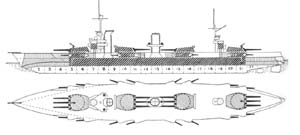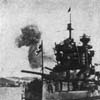GANGUT (ex- Oktiabrskaya Revolutia, ex-Gangut, October 7, 1911)
SEVASTOPOL (ex-Pariskaya Kommuna, ex-Sevastopol, June 20, 1911)
|
Displacement: 23,606 tons, 26,000 tons full
load Complement: 1125 (1230 as flagship). Length: (o.a.) 619 feet, (w.l.) 590 1/2 feet, (o.a.) 620 1/2 feet Beam: 87 feet Draught: 27 1/2 feet Guns: (Gangut): 12 - 12 inch, 52 cal. 10 - 4,7 inch, 50 cal. 8 - 3 inch AA. 12 - 37 mm. AA. Torpedo tubes (18 inch): 4 submerged (Sevastopol): 12 - 12 inch, 52 cal. 16 - 4,7 inch, 50 cal. 6 - 3 inch AA. 16 - 37 mm. AA. |
Armour: (Krupp): 8 3/4" Belt (amidships) 5" - 2" Belt (ends) 3" - 4" Internal belt (see notes) 3" Deck 12" - 10" Turrets 8" Turret bases 6" Battery 10" Conning tower Machinery: Parsons turbine. 4 shafts. Designed H.P. 42,000=23 kts (full power about 50,000 = 23.4kts). Boilers: 25 Yarrow in Gangut, 22 of 3-drum type in Sevastopol (installed 1938). Coal normal, 1,000 tons; maximum, 2000 tons. Also 1,170 tons oil. Radius of action: 900 miles at 23 kts., 4,000 miles at 16 kts. |

|
|
|
|
|
|
|
|
|
|
|
|
|
|
|
|
|
|
|
|
|
|
|
|
|
|
|
|
Armour notes: Belt is about 15 feet wide, 5 feet of it below water, uniform thickness. There is a secondary 3" - 4" internal belt 11 feet inboard above protective deck, extending between the end barbettes. The space between main belt and internal belts is divided up into w.t. compartments.
General notes: The late Gen. Wittorio Cuniberti prepared the original designs for this type. The Ministry of Marine afterwards altered the plans to include Russian ideas of armouring, ice-breaking bows and other special features. Further, to obtain a higher speed, hull design is relatively lighter than in contemporary battleships of other fleets. Said to be most unhealthy, insanitary and badly ventilated. Early in 1930 Sevastopol proceeded to Black Sea where she was refitted. Gangut refitted 1926-28. A third ship, Petropavlovsk (ex-Marat), was so badly damaged forward by enemy air attack at Kronstadt in 1941 that she is reported to have been scrapped.
 SEVASTOPOL |
MARAT |
|
|
GANGUT |
 GANGUT |